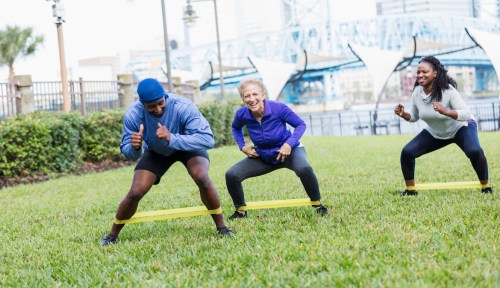Exercising With Osteoporosis: Here’s How To Maximize the Bone Health Benefits—While Staying Safe
Learn why exercising with osteoporosis takes a specialized bone-health-focused approach, according to experts.

Being given an osteoporosis diagnosis can be intimidating—and raise a lot of questions. What does this mean for your lifestyle? Can you even work out anymore?
Experts in This Article
board-certified family physician and geriatrician, and director of Geriatric Cognitive Health for the Pacific Neuroscience Institute
Experts stress that exercising with osteoporosis is not only possible, it’s definitely recommended when you have the bone condition. “It is essential to exercise when you have osteoporosis,” says Evan Johnson, PT, director of Och Spine Care Outpatient Physical Therapy at NewYork-Presbyterian. “Exercise, along with diet and medication, can stimulate bone growth, increase bone density, and prevent future bone thinning.”
Thought exercising is important when you have osteoporosis, there are special considerations to keep in mind in order to do it safely. Here’s what you need to know to go about working out safely.
What are good workout goals when you have osteoporosis?
Osteoporosis is a bone disease that develops when bone mineral density and bone mass decreases, or when the structure and strength of the bone decreases, according to the National Institute of Arthritis and Musculoskeletal and Skin Diseases. This raises the risk of developing broken bones, and is the major cause of fractures in postmenopausal women and older men.
So what does that mean for your workouts? It’s still a good idea to follow the recommended guidelines for exercise when you have osteoporosis, says Scott Kaiser, MD, a board-certified geriatrician and director of Geriatric Cognitive Health for the Pacific Neuroscience Institute in Santa Monica, California. That means aiming to do at least 150 minutes of moderate-intensity cardio and two days of muscle-strengthening activity each week.
“In terms of overall goals, trying to improve bone density, enhancing balance and posture, and building muscle strength are important,” Dr. Kaiser says. “More globally, you’re trying to reduce the risk of falls and to prevent fractures if you do fall.”
Which exercises are best for osteoporosis?
It’s a good idea to focus on osteogenic exercises, which are exercises that stimulate bone growth, Dr. Johnson says. “Bone growth is stimulated through applying a load on the bone as a result of body weight or the pull of a muscle during resistance exercise, such as exercises using light weights or resistance bands,” he says.
Top bone-building exercises
Experts say these exercises can be helpful for building stronger bones when you have osteoporosis:
- Walking
- Climbing stairs
- Bodyweight exercises
- Strength training
- Dancing
- Elliptical training
- Resistance band moves
- Yoga
- Pilates
Swimming and cycling have plenty of perks, but the Mayo Clinic points out that they don’t have enough weight-bearing load to build bone density.
Remember your upper body
Don’t neglect your arms while you’re working out. “Increasing bone density of the arms and wrists requires that you either bear weight on the arms—performing exercises on all fours or a push-up—or perform resistance training with bands or weight,” Dr. Johnson says. “In resistance training, the pull of the muscles on the bone stimulates the bone to grow.”
Working on your balance and posture can be helpful, too, which is why yoga can come in handy, Dr. Kaiser says.
“The most commonly-suffered fractures due to osteoporosis occur in the spine, hip, wrist, and forearm,” Dr. Johnson says. “It is important to combine weight-bearing exercises for the legs and spine, with some form of resistance training for the wrists and arms.”
Keep that core (and those hips) strong
Dr. Kaiser also suggests focusing on doing core work and building up muscles in your legs, especially around your hips and glutes (aka your butt). “Those will help you to stay upright to reduce your risk of falling,” Kaiser says. “And, should you fall, those muscles become a big part of your protective response, insulating your bones from the force of the fall.”
What exercises should you avoid when you have osteoporosis?
While weight-bearing exercises are good for bone growth, high-impact workouts can be dangerous for people who have bone thinning or osteoporosis, Dr. Johnson says. That’s why he recommends avoiding these exercises:
- Running
- Jumping
- Sit-ups
(While they’re not high-impact, sit-ups put a lot of pressure on your spine and “can result in spinal or rib fractures,” Dr. Johnson says.)
Take a balanced approach
This doesn’t mean you need to walk 10 miles every day—or that walking can replace medication. But bone-building exercises should be one part of your overall approach to maintaining bone strength, says Dr. Johnson. “Good nutrition, remaining active and maintaining adequate vitamin D and calcium levels are great first line ways to minimize the risk of developing osteoporosis,” he says.
And if you’re not sure if your workout routine is safe or effective? Check in with your doctor. They can help provide personalized guidance.
Sign Up for Our Daily Newsletter
Get all the latest in wellness, trends, food, fitness, beauty, and more delivered right to your inbox.
Got it, you've been added to our email list.










